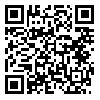Volume 20, Issue 3 (َAutumn 2023)
bloodj 2023, 20(3): 189-195 |
Back to browse issues page
Download citation:
BibTeX | RIS | EndNote | Medlars | ProCite | Reference Manager | RefWorks
Send citation to:



BibTeX | RIS | EndNote | Medlars | ProCite | Reference Manager | RefWorks
Send citation to:
Samadi Ivriq M, Oodi A, keikhaei B, Mohammadi S. Prevalence of alloimmunization in patients with sickle cell anemia in Khuzestan province. bloodj 2023; 20 (3) :189-195
URL: http://bloodjournal.ir/article-1-1491-en.html
URL: http://bloodjournal.ir/article-1-1491-en.html
Abstract: (1673 Views)
Abstract
Background and Objectives
Sickle Cell Disease is the second most common hemoglobinopathy after thalassemia and is characterized by vascular occlusion and hemolytic anemia. Blood transfusion is considered as a supportive treatment for patients with sickle cell disease. The alloimmunization of red blood cells is a major challenge in these patients. Accordingly, supplying the appropriate antigen-negative blood units is a major problem in blood transfusion. The aim of this study was to evaluate the alloimmunization rates among individuals with Sickle Cell Disease in Khuzestan province.
Materials and Methods
In this descriptive cross-sectional study, a total of 184 patients with sickle cell anemia and sickle-thalassemia were referred to the Shahid Beqaei hospital in Ahvaz. 5-10 mL of peripheral blood containing the anticoagulant EDTA was collected by non-random sampling procedure. The prevalence of phenotypes and the rate of alloimmunization were determined by the hemagglutination technique.
Results
The prevalence of alloimmunization in this population was 13.0%. In 24 patients, twelve types of alloantibodies were detected. The most common alloantibodies were Anti-E (33.3%, n = 8), Anti-c (20.8%, n = 5), Anti-D (16.6%, n = 4), and Anti- Kell (16.6%, n = 4).
Conclusions
Antibody against Rh blood group system and anti-Kell were the most prevalent alloantibodies among sickle cell anemia patients in the province of Khuzestan. Therefore, it is highly recommended to transfuse these individuals with blood units compatible with the Rh (D, C, c, and E) and Kell antigens.
Background and Objectives
Sickle Cell Disease is the second most common hemoglobinopathy after thalassemia and is characterized by vascular occlusion and hemolytic anemia. Blood transfusion is considered as a supportive treatment for patients with sickle cell disease. The alloimmunization of red blood cells is a major challenge in these patients. Accordingly, supplying the appropriate antigen-negative blood units is a major problem in blood transfusion. The aim of this study was to evaluate the alloimmunization rates among individuals with Sickle Cell Disease in Khuzestan province.
Materials and Methods
In this descriptive cross-sectional study, a total of 184 patients with sickle cell anemia and sickle-thalassemia were referred to the Shahid Beqaei hospital in Ahvaz. 5-10 mL of peripheral blood containing the anticoagulant EDTA was collected by non-random sampling procedure. The prevalence of phenotypes and the rate of alloimmunization were determined by the hemagglutination technique.
Results
The prevalence of alloimmunization in this population was 13.0%. In 24 patients, twelve types of alloantibodies were detected. The most common alloantibodies were Anti-E (33.3%, n = 8), Anti-c (20.8%, n = 5), Anti-D (16.6%, n = 4), and Anti- Kell (16.6%, n = 4).
Conclusions
Antibody against Rh blood group system and anti-Kell were the most prevalent alloantibodies among sickle cell anemia patients in the province of Khuzestan. Therefore, it is highly recommended to transfuse these individuals with blood units compatible with the Rh (D, C, c, and E) and Kell antigens.
Type of Study: Research |
Subject:
Imunohematology
Send email to the article author
| Rights and permissions | |
 |
This work is licensed under a Creative Commons Attribution-NonCommercial 4.0 International License. |






